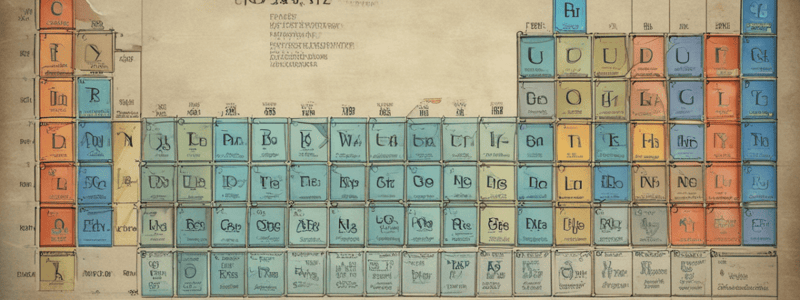Podcast
Questions and Answers
What is the primary purpose of the Periodic Table of Elements?
What is the primary purpose of the Periodic Table of Elements?
- To display the atomic mass of each element
- To show the location of elements on the planet
- To provide information about the properties of each element (correct)
- To list all the elements in alphabetical order
What is unique about the atoms within an element?
What is unique about the atoms within an element?
- They have different masses
- They are composed of different elements
- They can be broken down further
- They are identical and unique to that element (correct)
What did Johann Dobereiner create in 1829?
What did Johann Dobereiner create in 1829?
- A new element
- A chemistry laboratory
- The modern Periodic Table
- A triad of elements (correct)
What was the limitation of Dobereiner's triad theory?
What was the limitation of Dobereiner's triad theory?
What can be found in each element's box on the Periodic Table?
What can be found in each element's box on the Periodic Table?
Who is credited with creating the Law of Octaves?
Who is credited with creating the Law of Octaves?
What was the primary reason for inconsistencies in Mendeleev's periodic table?
What was the primary reason for inconsistencies in Mendeleev's periodic table?
What is the number of protons in an element that defines it, according to Henry Moseley?
What is the number of protons in an element that defines it, according to Henry Moseley?
How many groups are there on the periodic table?
How many groups are there on the periodic table?
What type of elements are classified as metalloids on the periodic table?
What type of elements are classified as metalloids on the periodic table?
What is true about elements in the same group?
What is true about elements in the same group?
What tends to increase as you go across a period in the periodic table?
What tends to increase as you go across a period in the periodic table?
What is true about metals?
What is true about metals?
What is true about the atomic radius of elements in the periodic table?
What is true about the atomic radius of elements in the periodic table?
What is characteristic of atoms with a high oxidizing nature?
What is characteristic of atoms with a high oxidizing nature?
Flashcards are hidden until you start studying
Study Notes
The Periodic Table of Elements
- A widely used tool in chemistry, organized to include all discovered elements.
- Each element is composed of identical atoms, unique to that element.
- Element's box on the periodic table lists atomic number, symbol, name, and atomic mass.
History of the Periodic Table
- Johann Dobereiner (German chemist) created a triad in 1829, grouping elements by similar properties.
- John Newlands (English chemist) organized elements by increasing atomic weight and noted patterns in 1863.
- Dmitri Mendeleev (Russian chemist) created the modern periodic table, organizing elements by increasing atomic weight and discovering patterns.
- Henry Moseley (English chemist) improved the periodic table by organizing elements by atomic number in 1913.
Periodic Table Organization
- Organized into columns (groups) and rows (periods).
- Periods are horizontal rows, with 7 periods on the periodic table.
- Groups are vertical columns, with 18 groups on the periodic table.
- Periodic table is divided into sections: metals, metalloids, and nonmetals.
Periodic Table Properties
- Valence electrons: increases across a period, same number in a group.
- Atomic radii: increases down a group, decreases across a period.
- Ionization energy: increases across a period, decreases down a group.
- Electronegativity: increases across a period, decreases down a group.
- Electron affinity: increases across a period, decreases down a group.
- Oxidizing nature: increases in the upper right corner of the periodic table.
- Metallic character: increases down a group, decreases across a period.
Studying That Suits You
Use AI to generate personalized quizzes and flashcards to suit your learning preferences.




